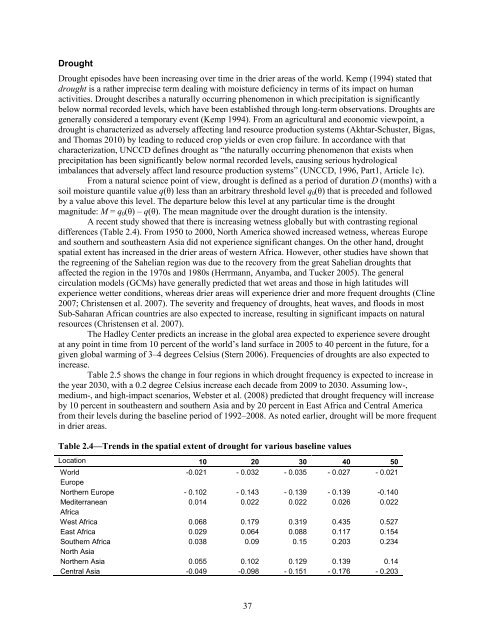The Economics of Desertification, Land Degradation, and Drought
The Economics of Desertification, Land Degradation, and Drought
The Economics of Desertification, Land Degradation, and Drought
Create successful ePaper yourself
Turn your PDF publications into a flip-book with our unique Google optimized e-Paper software.
<strong>Drought</strong><br />
<strong>Drought</strong> episodes have been increasing over time in the drier areas <strong>of</strong> the world. Kemp (1994) stated that<br />
drought is a rather imprecise term dealing with moisture deficiency in terms <strong>of</strong> its impact on human<br />
activities. <strong>Drought</strong> describes a naturally occurring phenomenon in which precipitation is significantly<br />
below normal recorded levels, which have been established through long-term observations. <strong>Drought</strong>s are<br />
generally considered a temporary event (Kemp 1994). From an agricultural <strong>and</strong> economic viewpoint, a<br />
drought is characterized as adversely affecting l<strong>and</strong> resource production systems (Akhtar-Schuster, Bigas,<br />
<strong>and</strong> Thomas 2010) by leading to reduced crop yields or even crop failure. In accordance with that<br />
characterization, UNCCD defines drought as “the naturally occurring phenomenon that exists when<br />
precipitation has been significantly below normal recorded levels, causing serious hydrological<br />
imbalances that adversely affect l<strong>and</strong> resource production systems” (UNCCD, 1996, Part1, Article 1c).<br />
From a natural science point <strong>of</strong> view, drought is defined as a period <strong>of</strong> duration D (months) with a<br />
soil moisture quantile value q(θ) less than an arbitrary threshold level q0(θ) that is preceded <strong>and</strong> followed<br />
by a value above this level. <strong>The</strong> departure below this level at any particular time is the drought<br />
magnitude: M = q0(θ) – q(θ). <strong>The</strong> mean magnitude over the drought duration is the intensity.<br />
A recent study showed that there is increasing wetness globally but with contrasting regional<br />
differences (Table 2.4). From 1950 to 2000, North America showed increased wetness, whereas Europe<br />
<strong>and</strong> southern <strong>and</strong> southeastern Asia did not experience significant changes. On the other h<strong>and</strong>, drought<br />
spatial extent has increased in the drier areas <strong>of</strong> western Africa. However, other studies have shown that<br />
the regreening <strong>of</strong> the Sahelian region was due to the recovery from the great Sahelian droughts that<br />
affected the region in the 1970s <strong>and</strong> 1980s (Herrmann, Anyamba, <strong>and</strong> Tucker 2005). <strong>The</strong> general<br />
circulation models (GCMs) have generally predicted that wet areas <strong>and</strong> those in high latitudes will<br />
experience wetter conditions, whereas drier areas will experience drier <strong>and</strong> more frequent droughts (Cline<br />
2007; Christensen et al. 2007). <strong>The</strong> severity <strong>and</strong> frequency <strong>of</strong> droughts, heat waves, <strong>and</strong> floods in most<br />
Sub-Saharan African countries are also expected to increase, resulting in significant impacts on natural<br />
resources (Christensen et al. 2007).<br />
<strong>The</strong> Hadley Center predicts an increase in the global area expected to experience severe drought<br />
at any point in time from 10 percent <strong>of</strong> the world’s l<strong>and</strong> surface in 2005 to 40 percent in the future, for a<br />
given global warming <strong>of</strong> 3–4 degrees Celsius (Stern 2006). Frequencies <strong>of</strong> droughts are also expected to<br />
increase.<br />
Table 2.5 shows the change in four regions in which drought frequency is expected to increase in<br />
the year 2030, with a 0.2 degree Celsius increase each decade from 2009 to 2030. Assuming low-,<br />
medium-, <strong>and</strong> high-impact scenarios, Webster et al. (2008) predicted that drought frequency will increase<br />
by 10 percent in southeastern <strong>and</strong> southern Asia <strong>and</strong> by 20 percent in East Africa <strong>and</strong> Central America<br />
from their levels during the baseline period <strong>of</strong> 1992–2008. As noted earlier, drought will be more frequent<br />
in drier areas.<br />
Table 2.4—Trends in the spatial extent <strong>of</strong> drought for various baseline values<br />
Location 10 20 30 40 50<br />
World -0.021 - 0.032 - 0.035 - 0.027 - 0.021<br />
Europe<br />
Northern Europe - 0.102 - 0.143 - 0.139 - 0.139 -0.140<br />
Mediterranean 0.014 0.022 0.022 0.026 0.022<br />
Africa<br />
West Africa 0.068 0.179 0.319 0.435 0.527<br />
East Africa 0.029 0.064 0.088 0.117 0.154<br />
Southern Africa 0.038 0.09 0.15 0.203 0.234<br />
North Asia<br />
Northern Asia 0.055 0.102 0.129 0.139 0.14<br />
Central Asia -0.049 -0.098 - 0.151 - 0.176 - 0.203<br />
37

















